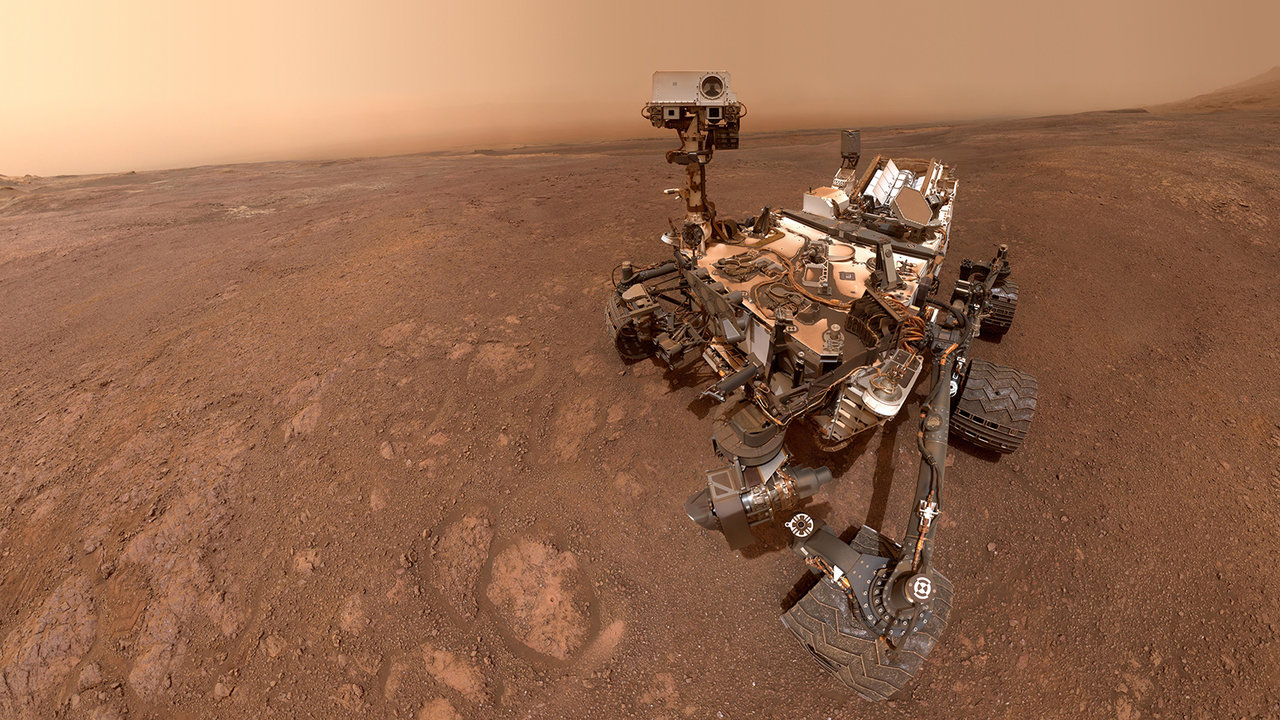News | January 31, 2019
'Mars Buggy' Curiosity Measures a Mountain's Gravity

A selfie taken by NASA's Curiosity Mars rover on sol 2291 (Jan. 15, 2019) at the "Rock Hall" drill site, located on Vera Rubin Ridge. Credit: NASA/JPL-Caltech/MSSS
Apollo 17 astronauts drove a moon buggy across the lunar surface in 1972, measuring gravity with a special instrument. There are no astronauts on Mars, but a group of clever researchers realized they have just the tools for similar experiments with the Martian buggy they're operating.
In a new paper in Science, the researchers detail how they repurposed sensors used to drive the Curiosity rover and turned them into gravimeters, which measure changes in gravitational pull. That enabled them to measure the subtle tug from rock layers on lower Mount Sharp, which rises 3 miles (5 kilometers) from the base of Gale Crater and which Curiosity has been climbing since 2014. The results? It turns out the density of those rock layers is much lower than expected.
Just like a smartphone, Curiosity carries accelerometers and gyroscopes. Moving your smartphone allows these sensors to determine its location and which way it's facing. Curiosity's sensors do the same thing but with far more precision, playing a crucial role in navigating the Martian surface on each drive. Knowing the rover's orientation also lets engineers accurately point its instruments and multidirectional, high-gain antenna.
Just like a smartphone, Curiosity carries accelerometers and gyroscopes. Moving your smartphone allows these sensors to determine its location and which way it's facing. Curiosity's sensors do the same thing but with far more precision.
By happy coincidence, the rover's accelerometers can be used like Apollo 17's gravimeter. The accelerometers detect the gravity of the planet whenever the rover stands still. Using engineering data from the first five years of the mission, the paper's authors measured the gravitational tug of Mars on the rover. As Curiosity ascends Mount Sharp, the mountain adds additional gravity — but not as much as scientists expected.
"The lower levels of Mount Sharp are surprisingly porous," said lead author Kevin Lewis of Johns Hopkins University. "We know the bottom layers of the mountain were buried over time. That compacts them, making them denser. But this finding suggests they weren't buried by as much material as we thought."
Science from a Mars Buggy
The Apollo 17 astronauts drove their buggy across the Moon's Taurus-Littrow Valley, periodically stopping to capture 25 measurements. Lewis has studied Martian gravity fields using data collected by NASA's orbiters and was familiar with Apollo 17's gravimeter.
The Science paper uses over 700 measurements from Curiosity's accelerometers, taken between October 2012 and June 2017. These data were calibrated to filter out "noise," such as the effects of temperature and the tilt of the rover during its climb. The calculations were then compared to models of Mars' gravity fields to ensure accuracy.
The results were also compared to mineral-density estimates from Curiosity's Chemistry and Mineralogy instrument, which characterizes the crystalline minerals in rock samples by using an X-ray beam. That data helped inform how porous the rocks are.
Mountain of Mystery
There are many mountains within craters or canyons on Mars, but few approach the scale of Mount Sharp. Scientists still aren't sure how the mountain grew inside of Gale Crater. One idea is that the crater was once filled with sediment. How much of it was filled remains a source of debate, but the thinking is that many millions of years of wind and erosion eventually excavated the mountain.
If the crater had been filled to the brim, all that material should have pressed down, or compacted, the many layers of fine-grained sediment beneath it. But the new paper suggests Mount Sharp's lower layers have been compacted by only a half-mile to a mile (1 to 2 kilometers) — much less than if the crater had been completely filled.
"There are still many questions about how Mount Sharp developed, but this paper adds an important piece to the puzzle," said study co-author Ashwin Vasavada, Curiosity's project scientist at NASA's Jet Propulsion Laboratory in Pasadena, California. JPL manages the Mars Science Laboratory mission that Curiosity is a part of. "I'm thrilled that creative scientists and engineers are still finding innovative ways to make new scientific discoveries with the rover," he added.
Lewis said that Mars holds plenty of mystery beyond Mount Sharp. Its landscape is like Earth's, but sculpted more by wind and blowing sand than by water. They're planetary siblings, at once familiar and starkly different.
"To me, Mars is the uncanny valley of Earth," Lewis said. "It's similar but was shaped by different processes. It feels so unnatural to our terrestrial experience."
For more about Curiosity, visit: https://mars.nasa.gov/msl/
For more about NASA's Mars program, visit: https://mars.nasa.gov
News Media Contact
Andrew Good
Jet Propulsion Laboratory, Pasadena, Calif.
818-393-2433
andrew.c.good@jpl.nasa.gov
2019-012
Page Updated: January 31, 2019
